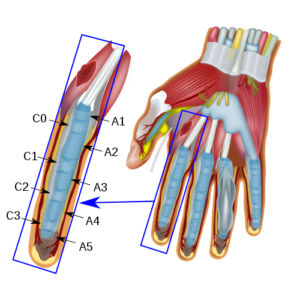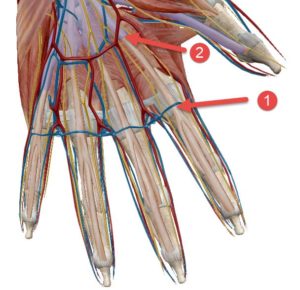7201 Hand and Wrist Pathology: Trigger Finger
Trigger finger, known medically as stenosing tenosynovitis, is a common condition that involves inflammation and swelling of the flexor tendons in the hand, which results in finger stiffness and a sensation of locking or catching. This paper aims to elucidate the anatomy and physiology behind trigger finger, detail its symptoms and clinical presentation, and explore the different diagnostic and treatment options available.
Keywords: Trigger finger, stenosing tenosynovitis, flexor tendons, tendon sheath, diagnosis, treatment
1. Anatomy and Physiology
Trigger finger is closely associated with the anatomy of the hand, particularly the flexor tendons and the tendon sheath. Flexor tendons are responsible for finger movement, enabling the bending or flexing of the fingers and thumb. These tendons run from the forearm through the wrist, passing through the carpal tunnel into the hand, and ending in the fingers. They glide smoothly through a protective sheath, the tendon sheath, which provides lubrication to decrease friction (Amadio, 2016).
In the condition known as trigger finger, inflammation or thickening occurs in the tendon sheath, which narrows the space through which the flexor tendon can glide. This can lead to the tendon catching or locking at the mouth of the tendon sheath, which can cause the finger to become stuck in a bent position. Triggering is caused by the mismatch between the diameter of the flexor tendon nodule and the entrance of the tendon sheath, also known as the A1 pulley (Schrier & Van Kan, 2020).
2. Symptoms and Clinical Presentation
The clinical presentation of trigger finger includes several common symptoms. Patients often report finger stiffness, particularly in the morning, along with a popping or clicking sensation when moving the affected finger. This is due to the tendon catching on the entrance of the tendon sheath (Amadio, 2016).
Another key symptom is the finger catching or locking in a bent position, which may suddenly pop straight. It might even reach a point where the affected finger cannot be straightened or bent at all. Pain is another commonly reported symptom, usually at the base of the affected finger or thumb (Ryzewicz & Wolf, 2006).
Physical examination often reveals a palpable nodule at the base of the finger on the palm side, which is sensitive to pressure and might move when the finger is flexed or extended (Schrier & Van Kan, 2020).
3. Diagnosis and Treatment Options
Trigger finger is primarily diagnosed through clinical examination. The physician assesses the patient’s hand for the presence of a nodule and the signature catching or locking sensation during finger movement. Additional imaging, such as an X-ray, is typically unnecessary but can be used to rule out other causes of hand pain such as arthritis or fracture (Ryzewicz & Wolf, 2006).
Treatment options for trigger finger range from non-surgical interventions to surgery, depending on the severity of the condition. Initial treatments include rest, splinting the finger to limit motion and reduce inflammation, and over-the-counter pain relievers. Corticosteroid injections are another common non-surgical treatment that can reduce tendon sheath inflammation (Wang & Bachoura, 2018).
Physical therapy exercises, designed to stretch and strengthen the finger muscles, can also be beneficial. For cases where conservative treatment is unsuccessful, surgical intervention is an option. Surgery involves releasing the affected section of the tendon sheath to allow the flexor tendon to glide smoothly. This can be done through open surgery or percutaneous release, which uses a needle to puncture the tendon sheath (Schrier & Van Kan, 2020).
In this condition, the index or thumb is experiencing a “catching” or feeling of locking of the normal movement. Sometimes there is a popping sound heard when moving a trigger finger which is one of the reasons for the name.
The cause of Trigger Finger is associated to a narrowing of the flexor sheaths surrounding the flexor tendons of the fingers. These sheaths are designed in a way that would provide for a bending movement of the fingers while also providing the necessary pulley action of the flexor tendons.

GFDL [CC BY-SA 3.0 (https://creativecommons.org/licenses/by-sa/3.0)], via Wikimedia Commons
When these sheaths become inflamed, they will reduce the inner diameter of the sheath causing a restricted movement of the tendon to the point where it catches or stops the flexion and sliding action inside the sheath.
The treatment for trigger finger focuses on the entire length of the finger with several placements spaced about ½ an inch apart from the pad to the base of the finger. Then place the tuning fork directly on the tip of the finger for at least two cycles. This location will ensure the vibrations will travel the entire length of the sheath. Finally, continue with placements from the base of the finger into the palm of the hand. Feel for the route of the flexor tendon and alternate placements on both sides of the tendon to loosen up the fascia, ligaments, and other tissue that may have been inflamed as a result of a sustained trigger finger condition.
Have the client bend the finger at regular intervals throughout the treatment to receive some feedback on your progress. Provide additional placements if there are areas of pain along the finger and hand.

Conclusion
Trigger finger is a condition that manifests due to a physical obstruction in the smooth gliding of the flexor tendon through the tendon sheath, resulting in symptoms like finger stiffness, locking, and pain. It can be diagnosed primarily through a clinical examination, and a range of treatment options are available, from non-surgical interventions to surgical procedures, depending on the severity of the condition.
References
Amadio, P. C. (2016). Stenosing flexor tenosynovitis (trigger finger). In J. M. Wolfe, R. L. Hotchkiss, W. C. Pederson, S. W. Kozin, & M. S. Cohen (Eds.), Green’s operative hand surgery (7th ed., pp. 228-243). Elsevier.
Ryzewicz, M., & Wolf, J. M. (2006). Trigger digits: principles, management, and complications. Journal of hand surgery, 31(1), 135-146.
Schrier, V. J., & Van Kan, H. J. (2020). Stenosing flexor tenosynovitis (trigger finger) – surgical treatment and complications: a systematic review. Journal of hand surgery European volume, 45(1), 72-80.
Wang, J., & Bachoura, A. (2018). Trigger finger: a review of the treatment options. Journal of Hand Surgery Global Online, 1(1), 35-40.
